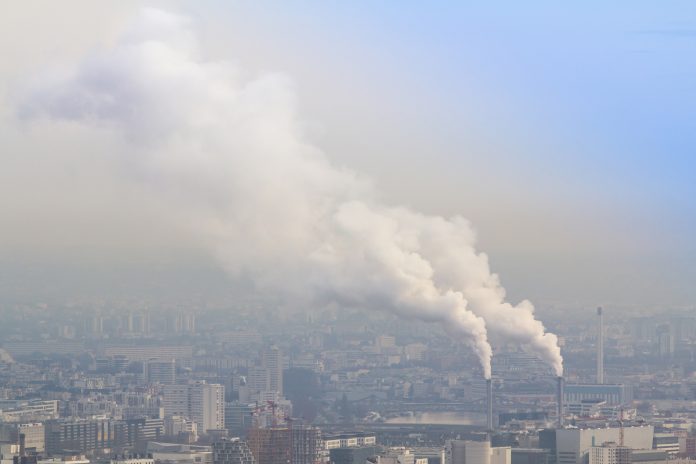
A team of researchers in China have identified a mechanism that explains how fine air pollution particles might cause lung cancer. The findings could lead to new approaches for preventing or treating the initial lung changes that lead to the disease, according to their study published in eLife.
“Tiny, inhalable fine particulate matter (FPM) found in air pollutants has been recognized as a Group 1 carcinogen and a substantial threat to global health. However, the cancer-causing mechanism of FPM remains unclear. Although fine particulate matter (FPM) in air pollutants and tobacco smoke is recognized as a strong carcinogen and global threat to public health, its biological mechanism for inducing lung cancer remains unclear,” wrote the investigators.
“Here, by investigating FPM’s bioactivities in lung carcinoma mice models, we discover that these particles promote lung tumor progression by inducing aberrant thickening of tissue matrix and hampering migration of anti-tumor immunocytes. Upon inhalation into lung tissue, these FPM particles abundantly adsorb peroxidasin (PXDN)—an enzyme mediating type IV collagen (Col IV) crosslinking—onto their surface. The adsorbed PXDN exerts abnormally high activity to crosslink Col IV via increasing the formation of sulfilimine bonds at the NC1 domain, leading to an overly dense matrix in the lung tissue. This disordered structure decreases the mobility of cytotoxic CD8+ T lymphocytes into the lung and consequently impairs the local immune surveillance, enabling the flourishing of nascent tumor cells.
“Meanwhile, inhibiting the activity of PXDN abolishes the tumor-promoting effect of FPM, indicating the key impact of aberrant PXDN activity on the tumorigenic process.
“In summary, our finding elucidates a new mechanism for FPM-induced lung tumorigenesis and identifies PXDN as a potential target for treatment or prevention of the FPM-relevant biological risks.”
To explore this possibility, Wang and the team collected FPM from seven locations in China and studied its effects on the main immune cells that defend against tumor growth–cytotoxic T-cells (CTLs). In mice administered with lung cancer cells that were not exposed to FPM, CTLs were recruited to the lung to destroy the tumor cells. By contrast, in the mice whose lungs were exposed to FPM, the infiltration of CTLs was delayed—potentially allowing the tumor cells to establish in lung tissue.“Despite its potential to cause mutations, recent research suggests that FPM does not directly promote, and may even inhibit, the growth of lung cancer cells,” explains first author Zhenzhen Wang, PhD, an associate researcher at Nanjing University (NJU), Nanjing, China, who carried out the study between labs at NJU and the University of Macau where she was sponsored by a University of Macau Fellowship. “This suggests that FPM might lead to cancer through indirect means that support tumor growth. For example, some studies suggest FPM can prevent immune cells from moving to where they are needed.”
To investigate why the CTLs did not enter the lung as quickly in the FPM-exposed lungs, the team studied both the CTLs themselves and the lung tissue structure. They found that CTLs exposed to FPM still retained their migratory ability, but that FPM exposure dramatically compressed the lung tissue structure and the spaces that immune cells move between. There were also much higher levels of collagen.
When the team studied the movement of CTLs in the mice, in lung tissue exposed to FPM, CTLs struggled to move, whereas those in the untreated tissue were able to move freely.
Further analysis of the tissue showed that the structural changes were caused by increases in a collagen subtype. collagen IV, but the team still did not know how FPM triggered this. They found the answer when they looked more closely at the structural changes to collagen IV and the enzyme responsible for making them peroxidasin, which drives a specific type of cross-linking that exposure to FPM was found to cause and aggravate in the lung tissue.
“The most surprising find was the mechanism by which this process occurred,” Wang says. “The peroxidasin enzyme stuck to the FPM in the lung, which increased its activity. Taken together, this means that wherever FPM lands in the lung, increased peroxidasin activity leads to structural changes in the lung tissue that can keep immune cells out and away from growing tumor cells.”
“Our study reveals a completely new mechanism by which inhaled fine particles promote lung tumor development,” concludes senior author Lei Dong, PhD, professor at the school of life sciences, Nanjing University. “We provide direct evidence that proteins that stick to fine particulate matter can cause a significant and adverse effect, giving rise to pathogenic activity. Our discovery that peroxidasin is the mediator of this effect in lung tissue identifies it as a specific and unexpected target for preventing lung disease caused by air pollution.”













